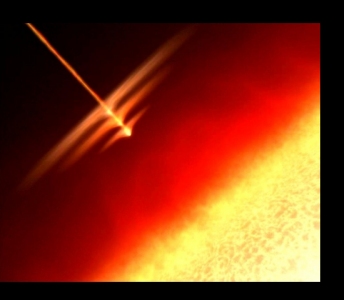|

In Star Trek, a geodesic fold is a temporary gateway
through space. They can be created by firing a geodesic pulse, a
verteron beam, into the magnetic field of a red giant star. As the
geodesic fold opens, a corresponding fold will open in the magnetic
field of another red giant, linking the two points. Communication
transmissions cannot pass through a geodesic fold. Geodesic folds,
however, emit high levels of geodesic radiation, which standard
Federation shields cannot withstand. Therefore, any ship attempting to
pass through will have all organic tissue aboard liquefied.
In 2377, DaiMon Nunk hatched a scheme to bring USS
Voyager to the Alpha Quadrant, so that he could sell Seven of Nine's
nanoprobes. He intercepted the hologram of Reginald Barclay and
programmed it to tell the Voyager crew that Starfleet had made advances
in shields and radiogenic vaccines that would allow them to pass safely
through a geodesic fold. From his marauder, Nunk created a geodesic
fold at a red giant, and another fold opened at red giant 23139 in the
Delta Quadrant. However, Barclay, posing as his hologram, was able to
bluff Nunk into collapsing the fold before Voyager could pass through.
(VOY: "Inside Man")
The term geodesic, in mathematics, is defined to be the
shortest path between points on the space or curves whose tangent
vectors remain parallel if they are transported along it. The term
"geodesic" comes from geodesy, the science of measuring the size and
shape of Earth; in the original sense, a geodesic was the shortest
route between two points on the Earth's surface, namely, a segment of a
great circle. Geodesics are of particular importance in general
relativity, as they describe the motion of inertial test particles.
While there is certainly no known phenomena in real
science known as a 'geodesic fold', it's principle certainly appears to
be similar to that of a wormhole - a hypothetical topological feature
of spacetime that is fundamentally a 'shortcut' through space and time.
The term wormhole was coined by the American theoretical physicist John
Wheeler in 1957. However, the idea of wormholes was theorized already
in 1921 by the German mathematician Hermann Weyl in connection with his
analysis of mass in terms of electromagnetic field energy. Spacetime
can be viewed as a 2D surface, and when 'folded' over, a wormhole
bridge can be formed. A wormhole has at least two mouths which are
connected to a single throat or tube. If the wormhole is traversable,
matter can 'travel' from one mouth to the other by passing through the
throat. While there is no observational evidence for wormholes,
spacetimes-containing wormholes are known to be valid solutions in
general relativity.
|
|
